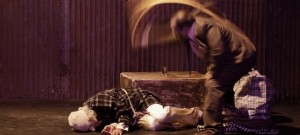
(Photo from D-CAF website)
I arrived at the theatre in not the best of moods, but with high hopes that this would soon change given the excellent performances I had previously seen during D-CAF. The world stood still for 60 minutes as I watched events in the play unfold, but at no point did the story manage to enthrall me or lift me out of reality.
What I expect from a play is to be immersed in its events so deeply that the world seems mundane after I return to it. Maybe that is setting the bar too high, but given the quality of the other plays I had attended it was a fair expectation. Sadly Le Prince Séquestré failed to deliver.
At first I thought the play was describing the situation in the countries of the Arab uprisings, with the clown resembling the people who were trapped by dictators represented by the clown’s employer. I thought the clown’s friend was the police who pretended to be on the people’s side but then betrayed them.
According to the D-CAF website: “In 2009, Cervantes and El Gretely decided to work together on the personage of the clown, a figure that does not exist in Egypt. The clown is also a symbol of incomprehension between the cultures: this half-wit who stumbles about without ever finding his place.
“In Le Prince Séquestré, Cervantes directs Hassan El Gretely and Boutros Raouf Boutros-Ghali, an emblematic actor in alternative theatre and cinema in Egypt. He writes of the cruel encounter between two friends who have not seen each other for years and who no longer recognise each other in a world that has been torn apart.
“Le Prince Séquestré is not, properly speaking, a clown show; clowns do not exist in Egypt. It is a play about the value of the present time in the breaking-down of events, in the profundity of history. It is like two men in a fragile boat without oars in a large lake, several metres away from a powerful grinding waterfall: Hassan and Pisso, comrades of many years at its centre.”
I did not really understand what the play wanted to portray. The clown did not know where he belonged and he appeared to have murdered his employer. The other person, whom the clown knows, is covered in blood for some reason. We do not know why. They hint at something happening Downtown, which I thought was a nod towards the Arab uprisings, especially because of the occasional noise of people shouting and guns being fired.
The clown thinks he is a prince who was kidnapped by his employer and kept prisoner. His friend also knows the clown’s employer, but he likes him and defends him. He then goes to see the employer who turns out to be alive, so we understand that the attempted murder by the clown was not successful. When he returns to his friend the clown he starts hitting him and drags him away from the stage, after which he scatters the clown’s belongings all over the stage.
The employer then appears (also played by El Gretely) and asks the friend about the whereabouts of the clown. The audience does not know whether the clown is dead or alive. The employer expresses that he is happy the clown has gone on to make a new life for himself and tells the friend he will not be able to return to his palace.
The play was in French with Arabic subtitles on screens positioned just below the stage, a technique that worked very well in the past. This time the translations only started to appear after the play began, forcing viewers to rely on their French translating abilities for the first five minutes or so. Needless to say the play confused me, even after the subtitles were fixed, which I would not have minded if I was entertained. Sadly, I was not. Both the actors were very expressive but the script was too vague to mean anything.




